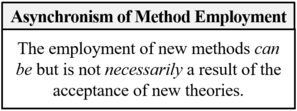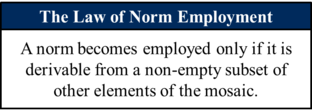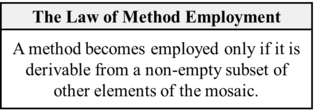Synchronism vs. Asynchronism of Method Employment
Which factors influence the process of method employment? Do new methods become accepted simultaneously with the acceptance of a theory?
This question is important to the scientonomic community because it aims to describe how a new method comes to be employed by a given community. It seeks to answer whether or not method employment necessarily depends upon theory acceptance and whether or not there exist instances in which the employment of a method might not follow the acceptance of a new theory.
In the scientonomic context, this question was first formulated by Hakob Barseghyan in 2015. The question is currently accepted as a legitimate topic for discussion by Scientonomy community.
In Scientonomy, the accepted answers to the question can be summarized as follows:
- The employment of new methods can be but is not necessarily a result of the acceptance of new theories.
- A method becomes employed only if it is derivable from a non-empty subset of other elements of the mosaic.
- A norm becomes employed only if it is derivable from a non-empty subset of other elements of the mosaic.
Contents
Broader History
The prehistory concerning synchronism versus asynchronism of method employment is rooted in a debate between Thomas Kuhn and Larry Laudan, the former promoting synchronism and the latter asynchronism. For Kuhn, science changes in phases, the first of which is normal science.[1] Normal science is marked by a consensus on the aspects of science that constitute a paradigm: concepts used in communication, the meaningfulness and relevance of some problems to research, and model solutions to research problems. Kuhn’s later formulation of a paradigm, a disciplinary matrix, includes laws, beliefs about the existence of objects/phenomena, values concerning research evaluation, and exemplary problems. Normal science is further characterized by an expectation that solutions will agree with problems previously researched. However, sometimes anomalies emerge in this agreement does not obtain. When anomalies are serious they can put pressure on the reigning paradigm. Serious anomalies eventually give way to a crisis in the paradigm, which calls for the modification or a revolutionary abandonment of the paradigm. Anomalies that strike at the foundation of the paradigm are often solved by new theories which, if accepted, culminate in a new consensus within the scientific community. This is known as a revolution. The new consensus among the community is not a cumulative progression from the old consensus; rather, the two paradigms are incommensurable with respect to the set of problems, the approaches to those problems, conceptual changes, and the world of the community’s research. Kuhn’s notion of incommensurability first tabled the discussion of the synchronism or asynchronism of method employment. According to Thomas Nickles (2017), the incommensurability of Kuhnian revolutions involves a wholesale change in goals as well as methodological standards and values.[2] Thus, in Kuhn’s system method employment necessarily depends upon theory acceptance, from which it follows that methods and theories change synchronously.[3] Larry Laudan, a critique of Kuhn, challenged this synchronism.[4] For him, research is conducted within the historical tradition of a given domain which that research can change.[5] Traditions are comprised of general assumptions about entities and processes. Problem solving, usually concerning anomalies, drives scientific change. Contra Kuhn, anomalies can be addressed by methodological or ontological changes instead of theory modifications. Severe anomalies in particular require alterations at both the methodological/ontological and theoretical levels.[6] Contrary to Kuhn, for whom “change is simultaneous rather than sequential,” Laudan regards method employment as separable from theory acceptance.[7] It is possible to change methodologies, which Laudan treats as methods, without accepting new theories.[8] A paradigm shift is not necessary for methods to change.[9] Consequently, methods and theory change can be asynchronous.
Scientonomic History
Acceptance Record
| Community | Accepted From | Acceptance Indicators | Still Accepted | Accepted Until | Rejection Indicators |
|---|---|---|---|---|---|
| Scientonomy | 2 November 2016 | This is when the community accepted its first answer to the question, Asynchronism of Method Employment theorem (Barseghyan-2015), which indicates that the question is itself legitimate. | Yes |
All Theories
| Theory | Formulation | Formulated In |
|---|---|---|
| Asynchronism of Method Employment theorem (Barseghyan-2015) | The employment of new methods can be but is not necessarily a result of the acceptance of new theories. | 2015 |
If an answer to this question is missing, please click here to add it.
Accepted Theories
| Community | Theory | Accepted From | Accepted Until |
|---|---|---|---|
| Scientonomy | Asynchronism of Method Employment theorem (Barseghyan-2015) | 1 January 2016 |
Suggested Modifications
Current View
Mirka Loiselle challenged the asynchronism of method employment theorem during the seminar of 2016. According to Mirka, the employment of a method is simultaneous to the acceptance of a proposition stating that the method is effective. Whether or not this poses a challenge to the theorem remains an open question.
In Scientonomy, the accepted answers to the question are Asynchronism of Method Employment theorem (Barseghyan-2015), The Law of Method Employment (Rawleigh-2022) and The Law of Norm Employment (Rawleigh-2022).
Asynchronism of Method Employment theorem (Barseghyan-2015) states: "The employment of new methods can be but is not necessarily a result of the acceptance of new theories."
The theorem states that the employment of a method is not necessarily simultaneous with the acceptance of a new theory. Being a direct logical consequence of the third law, the theorem highlights the fact that some methods are a result of the implementation of some abstract requirements of other methods. In this way, a new method can be devised as a means of resolving a particular creative gap, and subsequently become employed long after the acceptance of the theory that led to the employment of the abstract method.
Mechanism of Norm Employment
The Law of Norm Employment (Rawleigh-2022) states: "A norm becomes employed only if it is derivable from a non-empty subset of other elements of the mosaic."
Sebastien's law of method employment faces several problems. Foremost among these is that it is based on an outdated ontology that assumes that methods of theory evaluation are a fundamental epistemic element. After the acceptance of Barseghyan’s proposal that methods be subsumed under the category of normative theories, the third law no longer exhaustively covers all situations cases of employment. In its present form it is limited to methods, though there is no reason to think that the mechanism by which a method is employed is any different than the mechanism by which any other norm is employed.
In addition, Sebastien's formulation of the third law uses the term deducible, which currently lacks a scientonomic definition. We do not currently know what it means for something to be deducible, what the criteria of deducibility would be, or whether the conditions of deducibility would be part of the first-order theories of the mosaic or part of the second-order theories that range over the mosaic.
The third issue with Sebastien's formulation is that, with the acceptance of questions into the epistemic elements of the ontology of scientific change, the elements of the mosaic are now more expansive than just theories and subtypes of theories. This means that there is a plausible situation in which norms could potentially be derived – at least in part – from questions, which means that a formulation of the third law that excludes questions would fail to comprehensively describe all cases of norm employment.
The new law of norm employment aims to remedy all three of these issues:
- the formulation of the covers all norms rather than only methods;
- it replaces a deducible with derivable, which in the context of mathematical model theory simply means to be semantically entailed, and thus can potentially include non-deductive inferences (e.g. inductive, abductive);
- it replaces a specific enumeration of epistemic elements with a general "elements of the mosaic".
This formulation also offers the slight clarification that derivability strictly deals with derivation from a finite number of other elements.
Mechanism of Method Employment
The Law of Method Employment (Rawleigh-2022) states: "A method becomes employed only if it is derivable from a non-empty subset of other elements of the mosaic."
This law of method employment is a corollary of Rawleigh's law of norm employment. It implies that, just like the norms of all other types, methods become employed when they are derivable from other elements of the agent's mosaic (such as other theories, other methods, and perhaps even questions). As such, the law preserves most of the content of Sebastien's third law by solving some of the issues inherent in it.
See The Law of Norm Employment (Rawleigh-2022) for a more thorough exposition.
Related Topics
This question is a subquestion of Mechanism of Method Employment.
- ↑ Anderson and Hepburn. Scientific Change. Internet Encyclopedia of Philosophy. Stable URL: http://www.iep.utm.edu/s-change/.
- ↑ Nickles, Thomas, "Scientific Revolutions", The Stanford Encyclopedia of Philosophy (Winter 2017 Edition), Edward N. Zalta (ed.), URL = <https://plato.stanford.edu/archives/win2017/entries/scientific-revolutions/>
- ↑ Barseghyan, Hakob. (2015) The Laws of Scientific Change. Springer, pg. 151.
- ↑ Anderson and Hepburn. Scientific Change. Internet Encyclopedia of Philosophy. http://www.iep.utm.edu/s-change/.
- ↑ Laudan, L. (1977). Progress and Its Problems. Towards a Theory of Scientific Growth. Berkeley: University of California Press.
- ↑ Anderson and Hepburn. Scientific Change. Internet Encyclopedia of Philosophy. http://www.iep.utm.edu/s-change/.
- ↑ Laudan, L. (1986). Science and Values: The Aims of Science and their Role in Scientific Debate. University of California Press, pg. 69.
- ↑ Laudan, L. (1986). Science and Values: The Aims of Science and their Role in Scientific Debate. University of California Press, pg. 74.
- ↑ Laudan, L. (1986). Science and Values: The Aims of Science and their Role in Scientific Debate. University of California Press, pg. 81.
References
- a b c Andersen, Hanne and Hepburn, Brian. (2015) Scientific Method. In Zalta (Ed.) (2016). Retrieved from http://plato.stanford.edu/entries/scientific-method/.
- ^ Nickles, Thomas. (2017) Scientific Revolutions. In Zalta (Ed.) (2017). Retrieved from https://plato.stanford.edu/archives/win2017/entries/srevolutions/.
- a b c Barseghyan, Hakob. (2015) The Laws of Scientific Change. Springer.
- ^ Laudan, Larry. (1977) Progress and Its Problems. University of California Press.
- a b c Laudan, Larry. (1984) Science and Values. University of California Press.
- ^ Sebastien, Zoe. (2016) The Status of Normative Propositions in the Theory of Scientific Change. Scientonomy 1, 1-9. Retrieved from https://www.scientojournal.com/index.php/scientonomy/article/view/26947.


